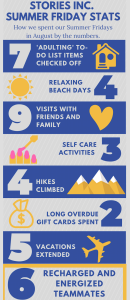There’s been a lot of talk about shortening the work week and work day lately. First, this company reduced the work week one day without adjusting compensation, and made a permanent change when productivity increased as a result. Then, Adam Grant suggested we shorten the work day to six hours, ending it when the school day ends (“We can be as productive and creative in six focused hours as in eight unfocused hours.”).
As if engagement and productivity aren’t enough to motivate business owners to rethink a traditional work schedule, here’s another thing to consider: More than half of Americans don’t use all the vacation time they earn. Some organizations have mandatory vacation because no one was taking the time they are owed; employee recharging wasn’t happening.
For several reasons, we closed our office every Friday in August, which amounted to about a week of time off per team member. I like this idea better than monitoring and mandating vacation. Personally, because I knew no one else was working, I found it easier to take time to really unplug. Also, because we made it clear no one was supposed to be working, I felt obligated to lead by example. Leaders, that’s a real consideration. According to a study from GfK Public Affairs and Corporate Communications and the U.S. Travel Association, 80 percent of employees said if they felt fully supported and encouraged by their boss, they would take more time off.
 So, you should consider why your workweek is structured the way it is, and how you might restructure it to better fit and improve your and your team members’ lives. Closing the office could be an option. In the end you could become a more engaged and productive collective (all good for business).
So, you should consider why your workweek is structured the way it is, and how you might restructure it to better fit and improve your and your team members’ lives. Closing the office could be an option. In the end you could become a more engaged and productive collective (all good for business).
And if you do it, realize this is something that will set you apart from other employers. This is your Fool’s Errand moment. It’s a recruitment marketing opportunity, a chance to bring your culture to candidates and further communicate your employer brand. We took August Fridays off for business reasons. But, we created content based on employee stories for recruitment marketing reasons.
Our teammate Anna wrote a blog post about how she spent her time off at a weekend yoga retreat, which she shared with her network. We created this infographic about our collective experience, which we posted to Facebook, LinkedIn, and Instagram.
We link to Scott’s blog in a job description. And we’ve written this article about it! We’ve created several different pieces of content in multiple forms that gives insight into what it’s like to work at Stories Inc., to include general culture, benefits, and the personalities and interests of the people that work there.
Because we received great feedback from our team about a four-day work week, with no negative impact in productivity or performance at the collective or individual level, we are keeping similar work hours throughout the fall. The takeaway: Think deeply about typically unquestioned conventions like your typical work-week structure and evaluate whether you can change it to better serve your team. If you find a way to increase engagement and workplace happiness through a change to convention, communicate it to candidates using your employees’ experiences.
